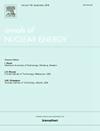硼酸盐基玻璃的光学和伽马射线衰减性能研究:BaO、ZnO和CaO掺杂的影响
IF 1.9
3区 工程技术
Q1 NUCLEAR SCIENCE & TECHNOLOGY
引用次数: 0
摘要
通过熔淬法制备了B2O3-Na2O中不同BaO、ZnO和CaO含量的玻璃系列,研究了其光学和辐射衰减特性。添加剂含量的增加增加了密度,使紫外吸收边缘向更长的波长移动,减小了能带隙(直接:3.859 ~ 3.494 eV;间接:3.305-2.797 eV),这是由于结构变化和非桥接氧原子(NBOs)的增加。该玻璃的折射率(2.319 ~ 2.454)、摩尔折射率(16.005 ~ 17.300)和光学碱度(1.256 ~ 1.324)增强,显示出较强的偏振性和金属特性,适合光学应用。辐射屏蔽研究表明,随着γ射线能量(0.015-10 MeV)的增加,线性衰减系数(LAC)下降。Na5Ca11玻璃(高BaO、ZnO和CaO)表现出最高的LAC,在0.2 MeV时超过了商用屏蔽玻璃,但落后于富pbo玻璃。随着光子能量的增加,lac值呈指数下降,Na5Ca11玻璃的lac值为107.828 ~ 1.129 cm−1,Na8Ca5玻璃的lac值为64.317 ~ 0.791 cm−1。与商用防护玻璃相比,制备的Na-Ca玻璃在0.2 MeV (0.539 ~ 0.715 cm−1)下的lac值高于RS 253和RS 253 G19,但由于其高PbO含量而低于RS 360和RS 323 G18。较高的添加剂含量提高了材料的密度、有效原子序数(Zeff)和辐射防护效率(RPE),在低能时RPE超过81%,在0.03 MeV时RPE达到100%,表现出较强的光学和伽马射线屏蔽潜力。本文章由计算机程序翻译,如有差异,请以英文原文为准。
Investigation of the optical and gamma-ray attenuation performance of borate-based glasses: Influence of BaO, ZnO, and CaO doping
A glass series with varying loadings of BaO, ZnO, and CaO in B2O3-Na2O was synthesized via melt-quenching to study optical and radiation attenuation features. Increasing additive contents raised density, shifted UV absorption edges to longer wavelengths, and reduced energy band gaps (direct: 3.859–3.494 eV; indirect: 3.305–2.797 eV) due to structural changes and an increase in non-bridging oxygen atoms (NBOs). An enhanced refractive index (2.319 to 2.454), molar refraction (16.005 to 17.300), and optical basicity (1.256 to 1.324) indicated strong polarization and metallic traits, making the glasses suitable for optical applications. Radiation shielding studies showed a decline in the linear attenuation coefficient (LAC) with increasing γ-ray energy (0.015–10 MeV). Na5Ca11 glass (high BaO, ZnO, and CaO) exhibited the highest LAC, surpassing commercial shielding glasses at 0.2 MeV but trailing PbO-rich glasses. The LACs decreased exponentially with increasing photon energy, ranging from 107.828-1.129 cm−1 for Na5Ca11 glass and 64.317–0.791 cm−1 for Na8Ca5 glass. Compared to commercial protective glasses, the prepared Na-Ca glasses exhibited higher LACs at 0.2 MeV (0.539–0.715 cm−1) than RS 253 and RS 253 G19 but lower than RS 360 and RS 323 G18 due to their high PbO content. Higher additive content improved density, effective atomic number (Zeff), and radiation protection efficiency (RPE), with RPE exceeding 81 % at low energies and reaching 100 % at 0.03 MeV, demonstrating strong optical and gamma-ray shielding potential.
求助全文
通过发布文献求助,成功后即可免费获取论文全文。
去求助
来源期刊

Annals of Nuclear Energy
工程技术-核科学技术
CiteScore
4.30
自引率
21.10%
发文量
632
审稿时长
7.3 months
期刊介绍:
Annals of Nuclear Energy provides an international medium for the communication of original research, ideas and developments in all areas of the field of nuclear energy science and technology. Its scope embraces nuclear fuel reserves, fuel cycles and cost, materials, processing, system and component technology (fission only), design and optimization, direct conversion of nuclear energy sources, environmental control, reactor physics, heat transfer and fluid dynamics, structural analysis, fuel management, future developments, nuclear fuel and safety, nuclear aerosol, neutron physics, computer technology (both software and hardware), risk assessment, radioactive waste disposal and reactor thermal hydraulics. Papers submitted to Annals need to demonstrate a clear link to nuclear power generation/nuclear engineering. Papers which deal with pure nuclear physics, pure health physics, imaging, or attenuation and shielding properties of concretes and various geological materials are not within the scope of the journal. Also, papers that deal with policy or economics are not within the scope of the journal.
 求助内容:
求助内容: 应助结果提醒方式:
应助结果提醒方式:


